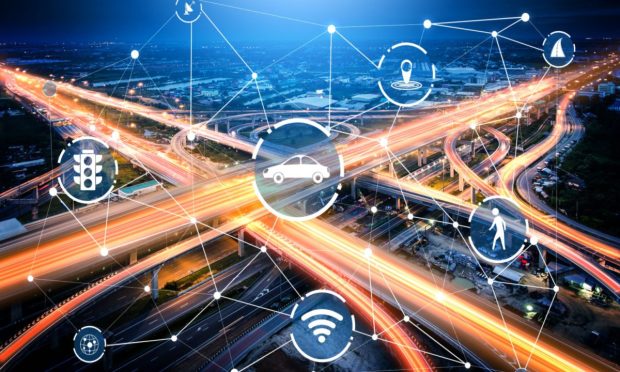Real-Time Data Untangles Traffic, Logistics, Insurance Challenges

When you look at an in-car navigation system, news broadcast or mobile app and roads marked with red, yellow and green designating the current traffic speeds, that information is coming from real-time data delivered via the cloud — using information from roadside sensors and intersection monitors, as well as from some 20 million connected vehicles in the U.S.
“There’s just billions and billions of GPS data points now, which mix in with accident and construction information and other kinds of data that might be out there, and that formulates the picture of what’s going on on the road right now,” Nick Kiernan, vice president of strategic account development at Iteris, told PYMNTS.
Iteris provides data like this to both public- and private-sector clients. In May, the company added customizable ClearData traffic management feeds to the range of mobility solutions it offers.
Smarter Routing Decisions
Commercial fleets and consumers alike use applications informed by traffic data to make daily decisions around their travel.
“You get to these decision points: Should I take the bridge or the tunnel today? Should I take the scenic route?” Kiernan said. “You’re doing this in your head, but you want more and more information, and you have all these other inputs to guide you.”
Public agencies use the data for traffic signal timing, congestion monitoring that controls the traffic flow getting onto interstate highways, safety messaging and variable speed limits. Longer term, these agencies also use the data to anticipate needs five or 10 years in the future.
For construction projects, traffic data is used to determine what the traffic flow is like now, what it’s expected to be like when the project is complete and then what it’s actually like when the project is complete. It’s also used to determine how travel times will be impacted during construction and how that effect can be mitigated.
“A lot of construction projects are increasingly tied to performance measures,” Kiernan said. “Did this project, which was funded by our tax dollars, improve the traffic flow as planned? More and more, those kinds of things are driven by data as opposed to observation.”
Adding Insurance Context
Auto insurers use traffic data to add context to the information they get from the smartphones or vehicles of customers who have opted in to usage-based insurance policies. For example, while data from the driver will show whether they’re driving within the speed limit, traffic data will show if they are driving with the flow of traffic.
“The example I often say is that the speed limit on the Jersey Turnpike is 55 miles an hour, so if you are driving 65 miles an hour, it looks like you’re driving unsafe because you’re driving 10 miles over the speed limit,” Kiernan said. “But, in reality, everybody else is driving 75 miles an hour. So, the real-time speed can provide a context to how you’re performing.”
One of the more non-traditional uses of traffic data is to use it to gauge economic life, as traffic conditions can be correlated with economic activity. Some work has been done, and more can be done, about how to more finely correlate the two.
“You saw some of those hints during the height of the pandemic when you might have seen a report or two about how traffic flows are changing and what that might imply for the overall economic view,” Kiernan said. “There were probably some early economic indicators that the country was emerging from the shell of the pandemic as traffic volumes and traffic speeds changed.”
Anticipating Payments Needs
Kiernan speculated that mobility data could eventually contribute to activities around payments. For example, as more and more electric vehicles hit the road, the data could contribute to a system that would help drivers find a charging station near a retail store that they’d like to visit, tell them if there’s a spot available, tell them how long it will take them to get there and then enable them to reserve a spot and pay for the charging.
“Those kinds of things will be influenced by this data,” Kiernan said. “It’s not there yet, but we’re trying to be sure that ClearData, which is kind of the picture of what’s going on on the road, is married up with the infrastructure data, which might include where the charging stations are, and fits into a payment structure.”
